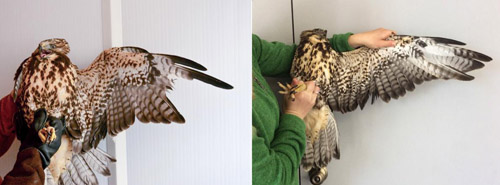How are hawks grafted?
Wildlife rehabilitation houses help recover the lost bird's feathered wings by taking feathers from another species attached to it.
How do you get feathers?
In the bird practice for a thousand years, it has been known to implant their feathers, Meghan Warren, rehabilitation coordinator of the Teton Raptor, Wilson, Wyoming State, Non-profit Animal Conservation Center. America said.

Left wing of Swainson hawk bird (left) and after implantation (right).(Photo: National Geographic)
According to National Geographic, unlike organ transplants, the implanted bird does not eliminate the implanted part , Warren said. " Implants are like hair extensions or artificial nails."
For raptors, or birds of prey, wings play an extremely important role. Last year, Raptor Teton center took care of three Swainson hawks whose wings had lost their feathers and suffered serious injuries.
Swainson is a species that lives in the dry western grasslands of North America. They are migratory birds, which often fly to Argentina to avoid cold weather. Their favorite food is grasshoppers or locusts, so they are called locust hawks or locusts. The bird is listed as a threatened species in the 2013 Red Book.
So far, one animal has been completely removed and released, but the other two are still being cared for at the center. One lost all of the hair on the left flank, and suffered severe hair follicle damage.
Rehabilitationists have given the animal a thyroid-enhancing drug, when it is preparing for a second molt. The results are very positive, the hair has grown back thicker, however, it breaks down the hair follicles at the tip of the wing.
These pipe feathers are very important, they are like serrated teeth for air to pass through and lift birds to fly, Warren said."And that's when we decided to graft."
However, not all hairs are suitable for Swainson hawks. Fortunately, Warren discovered feathers of osprey, a bird of prey, very suitable for Swainson birds.
Warren took the falcon feathers and used epoxy resin, a quick-drying plastic, attached to the hawk's feathers. She also used red-tail falcon feathers attached to hawks. As a result, the bird looked like it had a new wing, with all the feathers on its wings.
One day after the grafting, Warren and his team attached the creance wire, a thin piece of parachute cord, used in falconry, into hawks. On April 18, the bird was released back to the wild in the state of Idaho, northwestern America.
- Red hawk launched overhead
- Hawks lie on their backs because they are too full to eat
- Lightning fast attack of hawks with South American dragons
- Video: The hawk swooped down to hunt snake, unexpectedly squeezed hard
- Creating grafted tomatoes with disease resistance
- The grafted tomato variety is not enough to sell
- The 13,000
- Birds know how to use fire to fly bait to hunt
- Dak Lak develops yew trees from grafted varieties
- At the age of 8 months, 5 organs were grafted
- Australia: a battle of
- People are wiser or 'stupid'?
 'Fine laughs' - Scary and painful torture in ancient times
'Fine laughs' - Scary and painful torture in ancient times The sequence of numbers 142857 of the Egyptian pyramids is known as the strangest number in the world - Why?
The sequence of numbers 142857 of the Egyptian pyramids is known as the strangest number in the world - Why? History of the iron
History of the iron What is alum?
What is alum?